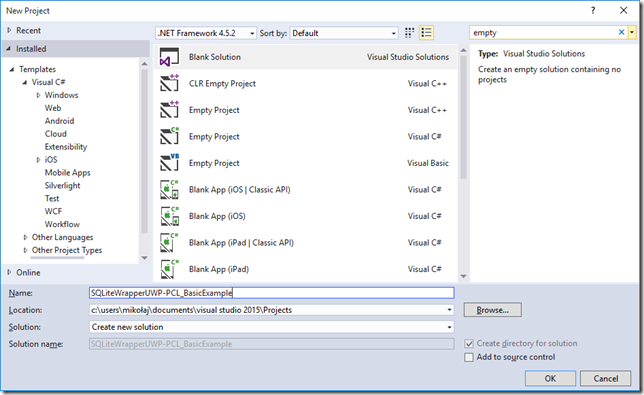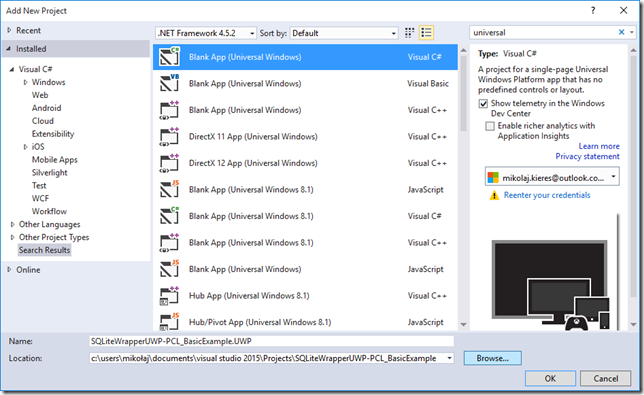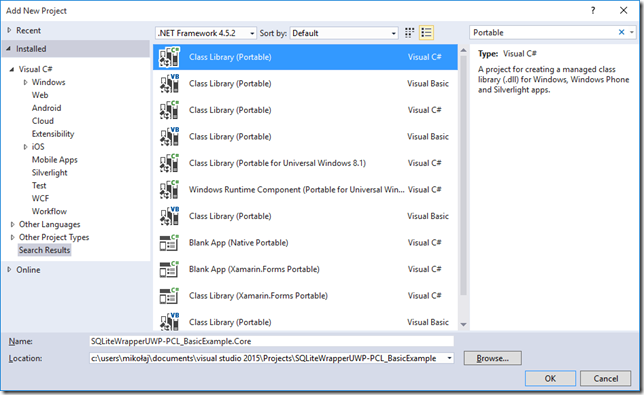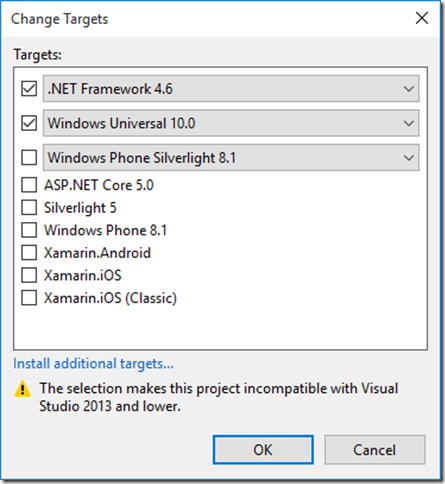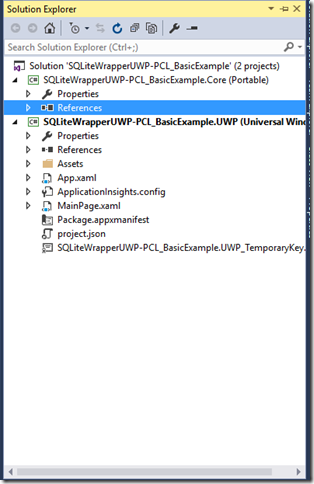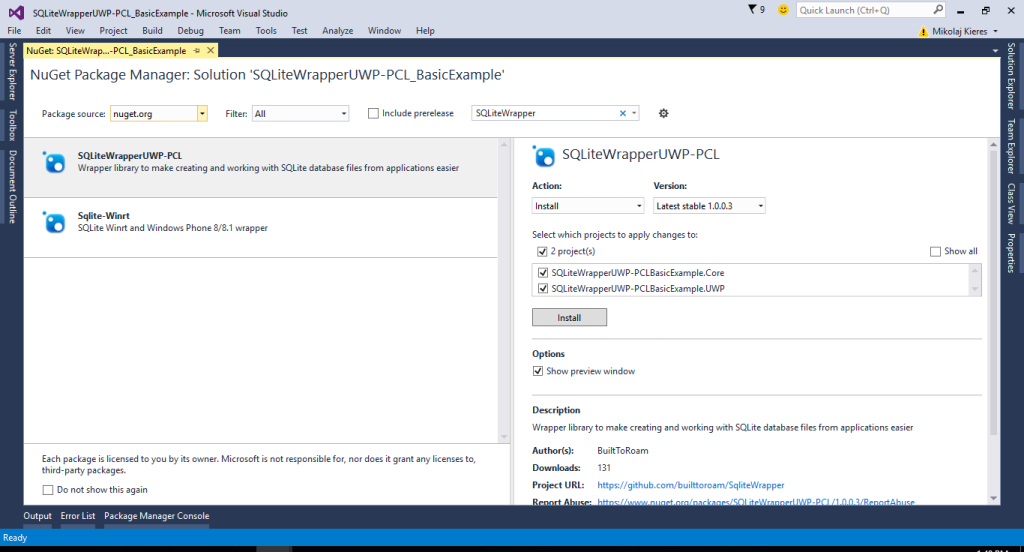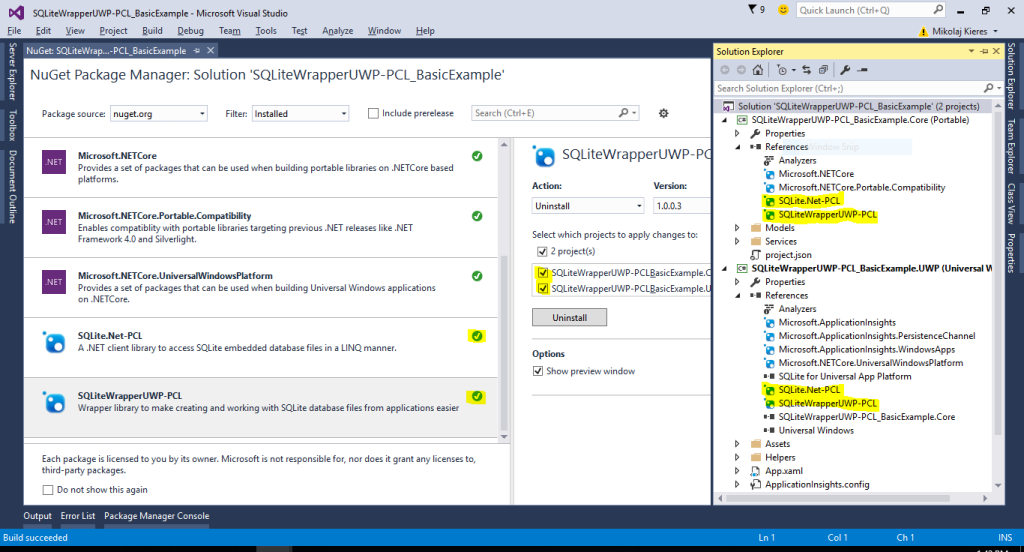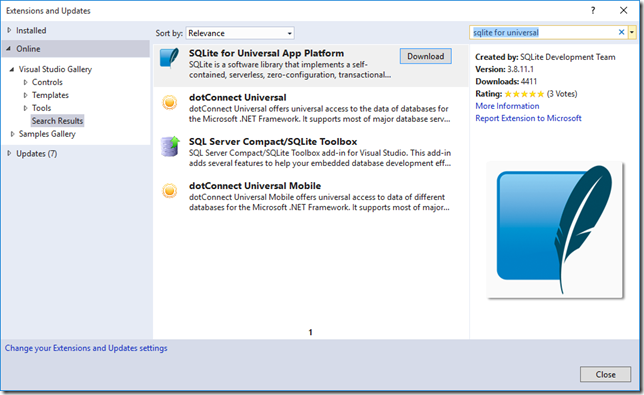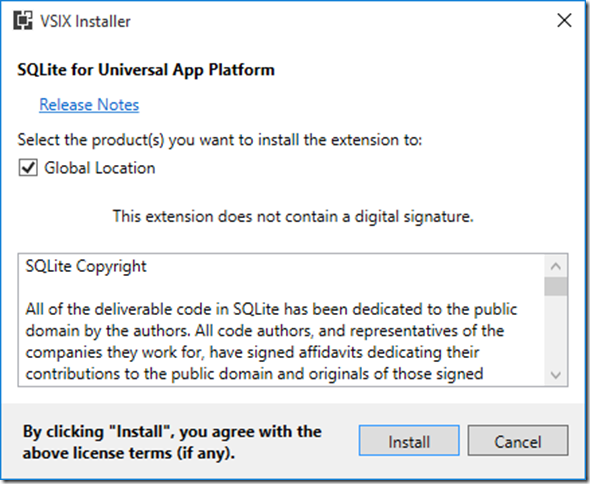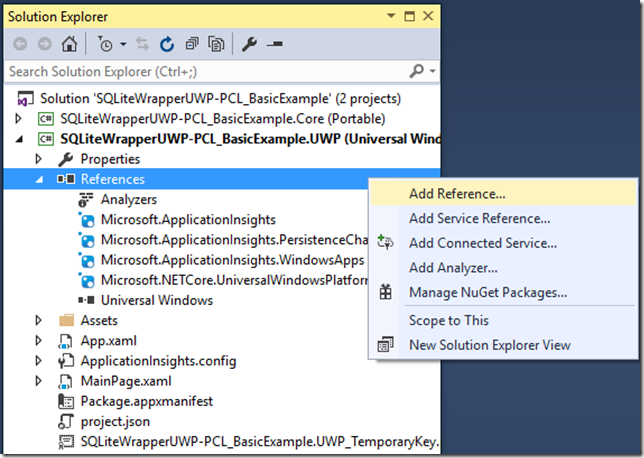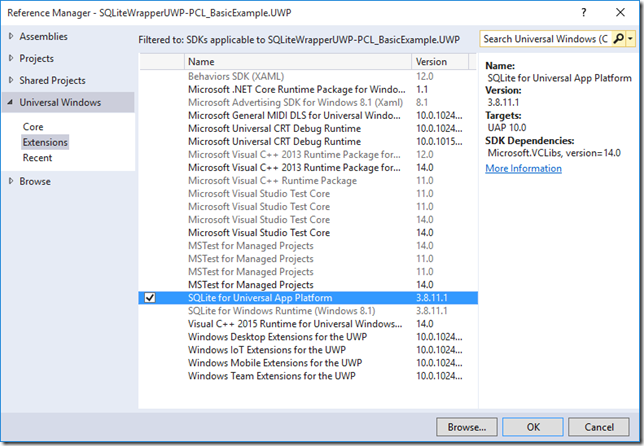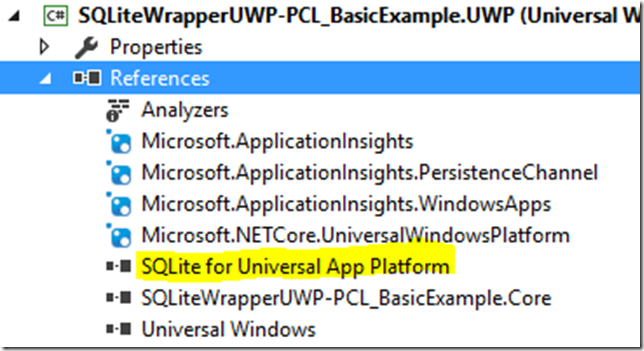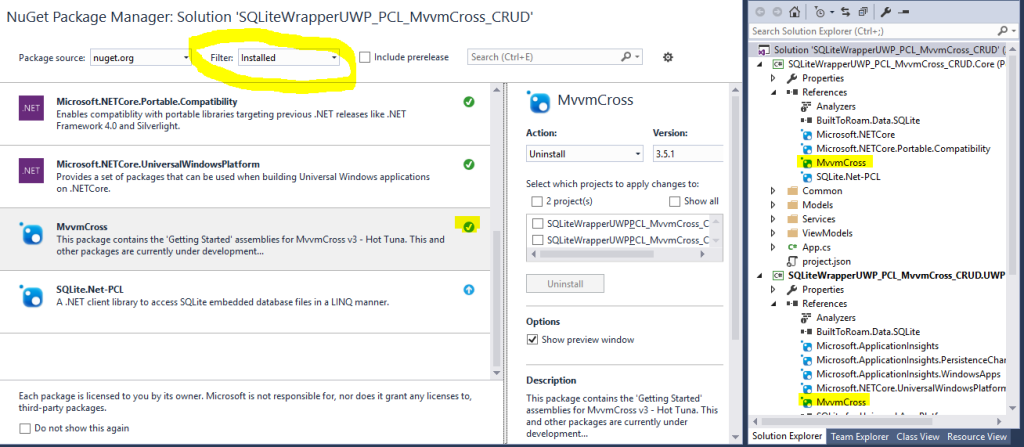The SQLiteWrapper story
The idea for SQLite Wrapper was purely dictated by the demand. We, at BuiltToRoam – company that I work at – are dealing with all types of universal application projects (Universal Apps for Windows 8.0-8.1 and Windows Phone 8.0-8.1 or UWP for Windows 10) that are required to use database(s). With every new application, we were basically re-using same code that was written for one of the previous apps. It was done in a really “savage” way, by copying and pasting core functionality and adjusting it accordingly to the needs of the app. Not good...something had to be done. The decision was made. We created a PCL (Portable Class Library) wrapper over SQLite.Net-PCL library that implements some basic functionality for Creating, Reading, Updating and Deleting (CRUD) operations on the database tables.
SQLiteWrapper came to life on a GitHub repository. From the beginning of it’s existence in the Open Source space I was tempted to create a NuGet package out of it. With NuGet package it would be much easier to distribute it and share it. On top of that, nothing would change in terms of GitHub repository, it would still be there so anyone could grab sources. Besides..I always wanted to have mine NuGet package, even though this one wouldn’t be strictly speaking mine. Even though it is a child that whole BuiltToRaom team gave birth to, I feel like at the moment I’m changing its dippers ;]. What’s more, creating this package could finally place myself on the map of .NET world!
I ended up reading some articles how to create a package, what should it consist in terms of information and description and a bit later..I present you SQLiteWrapperUWP-PCL! There’s still no information whatsoever about how to deal with it or how to use what’s inside of if. Therefore, I will try to fill this gap by guiding you, reader, through the process of creating a really basic example of SQLiteWrapperUWP-PCL usage.
The SQLiteWrapperUWP-PCL example
The project
Let’s start with creating an empty solution in Visual Studio 2015 – I’m using Community edition.
Next let’s add UWP project
Next add a PCL (Portable Class Library)
As you can see on the support selection screen (it appears after clicking OK on the dialog with Add New Project and choosing PCL), I’m selecting .NET Framework 4.6 and Windows Universal 10.0 (UWP).
After those steps you should end up, in your* Solution Explorer*, with something similar to this
Having that done, we can grab NuGet packages and add it to the project. As SQLiteWrapperUWP-PCL depends on the SQLite.Net-PCL library we it will be installed along side SQLiteWrapperUWP-PCL
New references should appear in both Core and UWP projects and in the NuGet Package Manger window green tick should appear next to libraries that were installed. Even after successful installation you still don’t seem to have SQLite.NET-PCL library referenced (in one or both of your projects) you should try installing it explicitly (by finding it in the NuGet Package Manager and installing it from there)
You’re probably aware that to work with SQLite database one need an SQLite extension. In our case it’s going to be UWP extension. You can download one from Visual Studio, by going Tools –> Extensions and Updates and then selecting on the left side Online –> Visual Studio Gallery and search for sqlite for universal
After downloading SQLite for Universal App Platform you will be prompted with installer confirmation dialog
Remember to restart Visual Studio after installation has finished. Now you will be able to Add reference of this extension to your UWP project.
Then navigate – left side panel – to Universal Windows. SQLite for Universal App Platform should be listed in Extensions
Click OK. Afterwards you should have your SQL extension visible under References in your UWP project
At some point you should add a reference to the Core (PCL) library in your UWP project. You can see that I already did that, look on the above screenshot, it sits just below the SQLite for Universal App Platform reference.
Last thing, that is not necessary but recommended is to install MvvmCross libraries. It can be done in the same way as we did with SQLiteWrapperUWP-PCL, which means that in the NuGet Package Manager find MvvmCross and install it in both projects. On the below screenshot you can see MvvmCross already installed
Installation of MvvmCross framework will most likely create some folders and files in your project. To get familiar with MvvmCross and it’s structures, concepts and files I would recommend reading and/or watching some videos from the N+1 days of MvvmCross blog posts.
In terms of preparing your project for this example that should be it, let’s proceed to the code part
The description, below, was for version of SQLiteWrapperUWP-PCL up to 1.0.0.3. For the new version you can find some information in my latest post on this subject
The code
Let’s start from the Core project and setting up the DatabaseService.
public class DatabaseService : BaseDatabaseService
{
public DatabaseService(ISqlitePlatformProvider sqlitePlatformProvider)
: base(sqlitePlatformProvider) { }
public override SQLiteConnection CreateAndOpenDb(string nativeDbPath)
{
var dbConnection = base.CreateAndOpenDb(nativeDbPath); dbConnection.CreateTable();
return dbConnection;
}
}
The base class – BaseDatabaseService – is the one that sits in our wrapper and is responsible for database management (e.g. creation, opening or closing). To create either BaseDatabaseService or in this case *DatabaseService *one will have to specify a constructor parameter of ISqlitePlatformProvider, I will explain that one in a moment. In the above code besides the constructor you can see an override of the CreateAndOpenDb method. It allows as to “plug in” between the creation of the database and returning connection to it. It’s done this way to make sure that before someone will start operating on the database (SQLiteConnection) they will have the proper entities – database tables – defined in it. In this case PersonEntity table is being created and afterwards dbConnection returned. Invoking dbConnection.CreateTable<PersonEntity>(); will map the model of our class to the database table. For more information about creating tables and mapping in general I'll refer you to the SQLite.NET-PCL git project site, where you can find some examples.
public class PersonEntity : BaseEntity
{
public string Name { get; set; }
public string Surname { get; set; }
}
PersonEntity is just an example of how you should structure your database entities. They should inherit from BaseEntity class so that you could use *BaseRepository *implementation – both of those classes are in the wrapper and about the second one I will talk in a moment. You should know that BaseEntity has a Id property which is decorated with [PrimaryKey] attribute and as you may suspect it will be mapped as a database table PrimaryKey.
Before explaining *ISqlitePlatformProvider *and *BaseRepository *concept I’ll quickly show you how I dealt with *PersonService *and Inserting and Retrieving data from database. Let’s start with very simple *IPersonService *interface that our service will implement
public interface IPersonService
{
List RetrieveAll();
void Insert(PersonEntity person);
}
As simple as two methods, Insert and RetrieveAll. Implementation will sit in the PersonService.
public class PersonService : IPersonService
{
private SQLiteConnection dbConnection;
public PersonService(SQLiteConnection dbConnection)
{
this.dbConnection = dbConnection;
}
public void Insert(PersonEntity person)
{
using (var personRepo = new BaseRepository(dbConnection))
{
personRepo.Insert(person);
}
}
public List RetrieveAll()
{
using (var personRepo = new BaseRepository(dbConnection))
{
return personRepo.Table.ToList();
}
}
}
Constructor takes SQLiteConnection which is the product of database service CreateAndOpen() method call*. *There’s also Insert and RetrieveAll implementation. Both use same pattern, which is *BaseRepository<TEntity>. *Repository part of the wrapper is the “thing” that you will deal with the most of the time. In above snippet of code I’m simply creating, for both methods, *new BaseRepository<PersonEntity>, *within using statement – because BaseRepository implements *IDisplosable interface – *which allows me to operate on my table (e.g. *personRepo.Insert(person) *or personRepo.Table.ToList()). Explore BaseRepository more to get familiar with functions that we exposed (e.g. *Get *or Delete).
That’s about it when it goes for Core*, *let’s move to the UWP project. Starting from mentioned earlier ISqlitePlatformProvider
public class SqlPlatformProvider : ISqlitePlatformProvider
{
public ISQLitePlatform SqLitePlatform { get; set; }
public SqlPlatformProvider()
{
SqLitePlatform = new SQLite.Net.Platform.WinRT.SQLitePlatformWinRT();
}
}
That one is pretty easy. It’s purely about platform specific implementation of SQLite.Net-PLC library and how it will handle all the “low level” SQL database stuff. In this case our platform will be SQLitePlatformWinRT.
Last but not least is to put all this together and insert and retrieve some actual database entries.
// Create a database service
var databaseService = new DatabaseService(new SqlPlatformProvider());
// Creats a db file
var dbFile = await ApplicationData.Current.LocalFolder.CreateFileAsync("test.db", CreationCollisionOption.OpenIfExists);
// Creates and opens db connection
var dbConnection = databaseService.CreateAndOpenDb(dbFile.Path);
// Creates person service
var personService = new PersonService(dbConnection);
// Retrieve all person from db
var persons = personService.RetrieveAll());
// Create new person
var newPerson = new PersonEntity()
{
Name = "Nick",
Surname = "Cage"
};
// Insert new person into db
personService.Insert(newPerson);
I hope the comments and my walk through will let you understand what’s happening in this snipped of code. If you still have doubts you should definitely try it yourself! Start from checking out this SQLiteWrapperUWP-PCL example project that you just read about.
NOTE: For inspecting SQLite database file(s) I recommend using SQLiteBrowser
